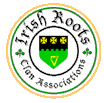|
|
Province Leinster County Kildare
|
|
|
| Ui Failghe (O’Connors Faly) | Ui Faolain (O’Byrnes) |
| Ui Muireadaigh (O’Tooles) | Ui Ciardha (O’Careys/O’Kearys) |
The ancient Gaelic septs of County Kildare were descended from Cathaoir Mor, King of Ireland, who died in 122 AD. The Ui Failghe (O’Connors Faly), ruled over the present day baronies of East and West Offaly and part of Laois. They lost some of their lands to the Fitzgeralds during the Anglo-Norman invasion, and the remainder during the plantations of Laois and Offaly. O’Connor comes from Conchobhar, meaning wolf-lover, which was quite a common early Irish name. From the Ui Failghe line evolved two prominent branches, the O’Dempseys, (from the Irish word diomasach, meaning proud) and the O’Dunnes, (from the Irish word donn, meaning brown-haired). Dunne is still a common name throughout County Kildare. For Dunn and Dempsey genealogy, coat of arms, history: Click Here. Dunn Family
The Ui Faolain (O’Byrnes), territory
was comprised of land in the baronies of Clane, North and South Salt and North
Naas. They were driven from their lands by the Anglo-Norman, Meyler Fitzhenry,
in the early 1200s, and eventually settled in Wicklow. The surname Byrne (from
the Irish name Bran, meaning raven) is widespread throughout the county.
A third family, the Ui Muireadaigh (O’Tooles),
were based in southern and south-east Kildare, around Moone, East and West
Narragh and Kilcullen. They lost land to Baron Walter de Riddlesford, following
the Anglo-Norman invasion, and settled in Wicklow. O’Toole comes from Tuathal,
meaning ruler of the people. The name originated with Tuathal, a King of
Leinster who died c. 960. While the name does occur in other parts of Ireland
the majority of O’Tooles/Tooles are descended from the County Kildare family.
The fourth sept of Kildare were the Ui Ciardha (O’Careys/O’Kearys), who had lands around the present day barony of Carbury. The territory was named Cairbre (Carbury), after one of the seven sons of Niall of the Nine Hostages, who was king of Ireland at the end of the fourth century.
The Fitzgeralds were one of the great families of County Kildare. The founder of
the family, Gerald, arrived in England with William the Conqueror and was
granted lands in Pembrokeshire, Wales. He married Nesta, a Welsh princess, and
they had four sons, one of whom, Maurice, took part in the Norman invasion of
Ireland in 1169. He was granted the territory of Offelan, part of present day
central Kildare, and it was from this beginning that the Fitzgerald family grew
in wealth and power. In May 1316, John Fitzthomas was created the first Earl of
Kildare. Though the passage of time saw constant fluctuations in the family
fortunes, it was the failed rebellion of Silken Thomas, son of Garret Og, the
ninth earl, in 1537, that ended the power of the Fitzgeralds.
Sources: A Guide to Irish Surnames, Irish Families and More Irish Families, Edward McLysaght, Dublin, Irish Academic Press. The Norman Invasion of Ireland, Richard Roche, Dublin, Anvil Books.
County Kildare Today:
The county is located in Leinster, part of the Great Central Plain, a region of rolling farmland on a limestone base, containing the Curragh Plain, and expanses of low lying peat land, the vast Bog of Allen. Kildare is bounded to the southwest by the granite sprawl of the Wicklow mountains, and by counties Meath to the north, Dublin to the east, Carlow to the south and Offaly and Laois to the west and southwest respectively. Two major rivers cut through Kildare soil, the Liffey which flows in a loop from the Wicklow mountains through Co. Kildare and into Dublin, and the Barrow which wends through Athy in the southern tip of the county.
The population was 99,065 in 1821. As a result of the great famine, the population in 1851 had held steadily at 95,723. During recent times, Kildare has grown considerably in demographic terms; the population of the county increasing from 71,977 in 1971 to 122,516 in 1991. There are more people living in the county now than at any time in its history. Part of this growth is due to a close proximity to Dublin, with towns such as Leixlip and Celbridge serving as dormitory towns. The other main centres of population in the county are Newbridge, Naas, Athy, Monasterevan, Kildare, and Maynooth. The chief industries are peat production, bloodstock, the manufacture of rope and carpets and Newbridge Cutlery, as well as food processing and textiles.
source: http://kildare.ie/library/KildareHeritage/page9.html




